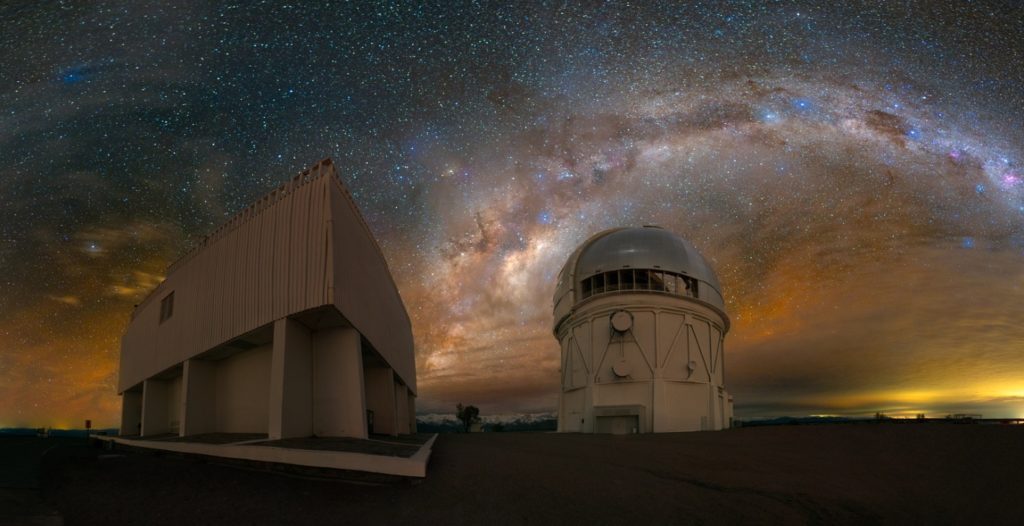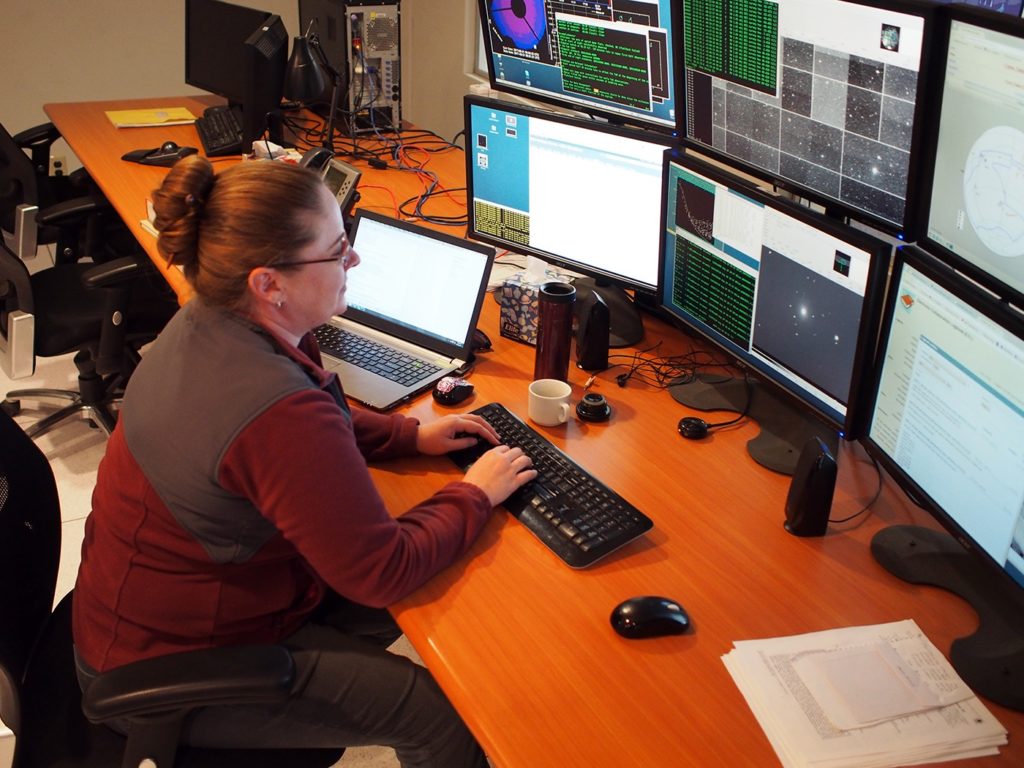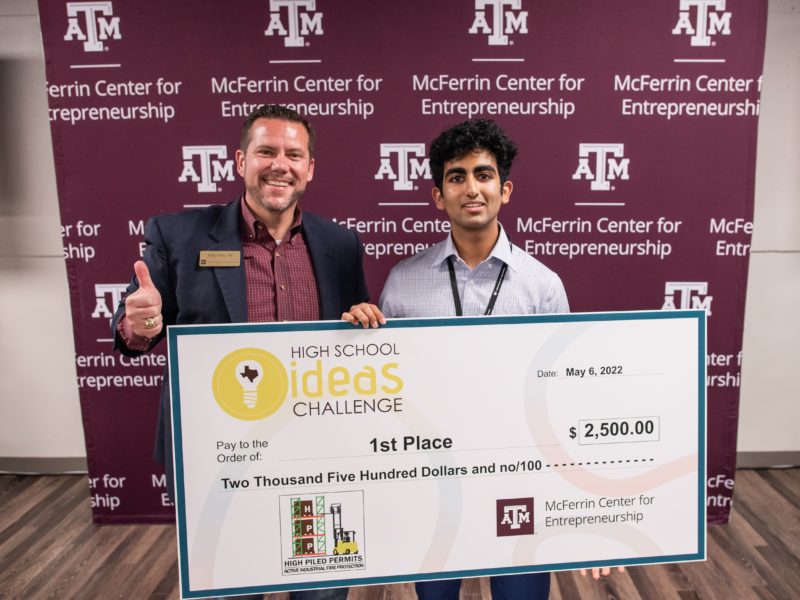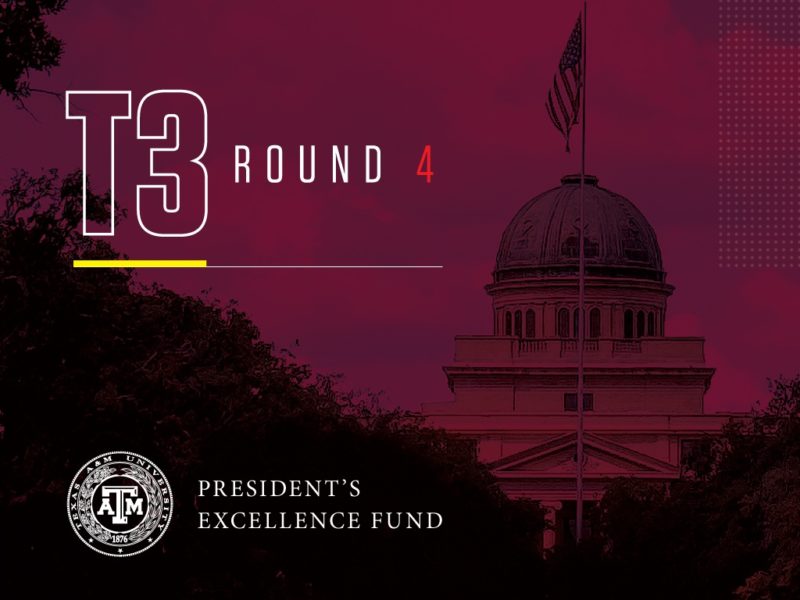August 17 dawned as the first day in an otherwise ordinary observing run for Texas A&M University astronomer Jennifer Marshall. She had arrived in Chile a few days earlier as part of another routine visit to the National Optical Astronomy Observatory’s Cerro Tololo Inter-American Observatory (CTIO), distinguished solely by the fact that it happened to kick off the fifth and final year of the Dark Energy Survey (DES), a five-year international project led by the U.S. Department of Energy’s Fermi National Accelerator Laboratory to map one-eighth of the sky in unprecedented detail.
However, just as swiftly as day turned to night and darkness descended over the Andes Mountains, Marshall found herself at the fateful crossroads of proximity and cosmic history, courtesy of one universally significant target of opportunity observation.
By virtue of being in the right place at the right time, Marshall got to witness firsthand the fiery aftermath of a recently detected burst of gravitational waves, personally recording some of the initial images of the first confirmed explosion from two colliding neutron stars ever seen by astronomers.
The discovery, historic because it marks the first cosmic event observed in both gravitational waves and light, was made using the U.S.-based Laser Interferometer Gravitational-Wave Observatory (LIGO); the Europe-based Virgo detector in Italy; and more than 60 ground- and space-based telescopes.
First cosmic event observed in both gravitational waves and light
During the course of seven days in Chile, Marshall watched the extraordinary event play out in real time through two telescopes — the 4-meter Victor M. Blanco Telescope at CTIO, then moving on to the 6.5-meter Magellan Telescope at nearby Las Campanas Observatory. She was the only astronomer present and observing for DES at Blanco during the unprecedented occurrence.
“It is my observation that every telescope in Chile, including the two I was using, was pointed at this thing for the entire week,” Marshall said. “It was definitely the most important science I have ever had the opportunity to be involved in.”
Images taken by Marshall using the 570-megapixel Dark Energy Camera (DECam) captured the flaring up and fading over time of a kilonova — an explosion similar to a supernova but on a smaller scale — that occurs when collapsed stars, called neutron stars, crash into each other, theoretically creating heavy radioactive elements.
This particular violent merger, which occurred 130 million years ago in a galaxy (NGC 4993) relatively near our own Milky Way galaxy, is the source of the gravitational waves detected by the LIGO and the Virgo collaborations on Aug. 17. Although this is the fifth source of gravitational waves to be detected, it is unique because it is the first one with a visible electromagnetic counterpart observable by optical telescopes — the glowing aftermath of the collision of two neutron stars — as opposed to binary black holes, which are not expected to produce a remnant that can be seen through telescopes.
Capitalizing on a Target of Opportunity
When DES officials at Fermilab learned along with dozens of LIGO-affiliated collaborations and observatories around the world that a strong gravitational signal, named GW170817, had been detected at 7:41 a.m. CDT by two of LIGO’s three detectors — a find further corroborated by a gamma-ray burst detected by NASA’s Fermi Gamma-ray Space Telescope at roughly the same time — they sent out a target of opportunity observation notice that Marshall quickly seized upon.
As she was observing at Blanco, Marshall was simultaneously collaborating via Skype with fellow DES scientists Marcelle Soares-Santos (Fermilab/Brandeis University), the DES principal investigator in charge of gravitational wave observations, and Daniel Holtz (University of Chicago), who is a member of both LIGO and DES. Coincidentally, Marshall also was sharing some of those nights via remote with Ting Li ’16, who earned her doctorate in astronomy at Texas A&M in 2016 working with Marshall and currently is a Lederman Fellow in Experimental Physics at Fermilab.
“LIGO tells you the equivalent of, ‘If you look in this area of the sky, there might be something,'” Marshall explained. “Virgo helped narrow that area down to the extent that, instead of 100 square degrees, it was only 30. DECam has a large field of view of three square degrees, so we only had to look at 30 telescope pointings. I was there with Erika Cook, our Munnerlyn Astronomical Laboratory control systems engineer, and Marcus Sauseda, an undergraduate aerospace engineering major here at Texas A&M, and we took some quick, short exposures — a total of roughly one hour. I sent the data off, then went to bed. I woke up to an ecstatic email from Edo Berger at Harvard, who happens to be a longtime colleague from our postdoc days at The Observatories of the Carnegie Institution of Washington.”
Armed with the crystal-clear images from DECam, for which Texas A&M astronomer Darren DePoy served as project scientist, Berger’s team went to work analyzing the phenomenon using several different resources, including NASA’s Hubble Space Telescope and Chandra X-ray Observatory. For her part, Marshall continued imaging the galaxy for five more nights at CTIO, watching the event fade rapidly and change in color from blue to red as the explosion quickly cooled down. She then spent a seventh night at Las Campanas, doing follow-up observation with the Magellan telescope, using a different spectrometer to enable more detailed study of the event in collaboration with Carnegie Observatories scientists Maria Drout and Ben Shappee.
Texas A&M Astronomers Play Key Roles In Neutron Star Collision Imaging, Analyses
Byproducts of a Binary Star Merger
Understandable excitement aside, Marshall says this event is particularly interesting to her because it is directly related her research on r-process elements — the heavy elements that exist on Earth and are produced in theory as the byproducts of neutron star collisions and mergers. These observations show that the theory is accurate, providing the final piece of the puzzle regarding the origin of r-process elements.
“This was the first time anyone has ever watched such an event play out from beginning to end, all thanks to LIGO,” Marshall said. “It was truly amazing. Watching science happen in real time is not something most astronomers get to experience. With the exception of supernovae and exoplanet studies, most things we work on take billions of years to play out. I felt so fortunate to be in the right place at the right time to help make perhaps one of the most significant observations of my career.”
Marshall said one indication of just how well LIGO/Virgo is working is the amount of event follow-up requests, which are so numerous as a result of its second and most recent observing run since being upgraded via a program called Advanced LIGO that astronomers have been forced to prioritize.
“There were actually several binary black hole mergers that same week that we didn’t bother to look at because the neutron star source was so much more important,” Marshall said. “We had absolutely no idea this was going to happen. Everyone was shocked, and understandably so, because it was truly unbelievable.”
In addition to Marshall and DePoy, fellow Texas A&M astronomers and Mitchell Institute members Lucas Macri, Casey Papovich, Nicholas Suntzeff and Louis Strigari are full members of the 400-plus-member international DES collaboration that spans 26 institutions and seven countries as well as the gamut of science and engineering in the search for answers regarding the universe’s accelerated expansion. Texas A&M statistician James Long and Mitchell Institute Postdoctoral Fellow Peter Brown also are external collaborators.
Publications Aplenty
The LIGO-Virgo results are published today in the journal Physical Review Letters, while additional papers from the LIGO and Virgo collaborations and the astronomical community either have been submitted or accepted for publication in various journals.
Six papers relating to the DECam discovery of the optical counterpart are planned for publication in The Astrophysical Journal. Preprints of all papers are available online.
Marshall’s observations made during that fateful August week in Chile appear in a total of nine publications making their debut today, including the mega paper from LIGO that includes citations for 75 associated papers, in addition to two DES-related papers appearing in The Astrophysical Journal as well as two papers in the journal Science featuring the Las Campanas spectra and images. Beyond those, she is an author on three additional DES papers, including one that uses the binary neutron star merger event to derive the Hubble constant. DePoy and Li join her as co-authors on several of those papers by virtue of their status as fellow DES Builders. Finally, she is an author on the Transient Optical Robotic Observatory of the South (TOROS) Collaboration paper in The Astrophysical Journal Letters.
For Marshall, the next publication wave will tie this new discovery to her previous work on ultra-faint dwarf galaxies in the nearby universe, which are highly dark matter-dominated and thought to be the building blocks of our Milky Way galaxy. Recently, some of these galaxies have been shown to be highly, and unexpectedly, enhanced in r-process elements. Because these galaxies were likely the first formed in the early universe, Marshall says detailed study of the site of r-process element production within them will lead to a better understanding of the first stars and galaxies formed in the universe and ultimately of the formation of structure in the universe as a whole.
“The August 17 binary neutron star merger event occurred in nearby galaxy NGC 4993, located at a distance of 39.5 megaparsecs from the Milky Way,” Marshall said. “This event will surely usher in a new field of science, the direct observational study of the formation of r-process elements starting now and being fueled by future discovery of similar events by LIGO and follow-up study by astronomers.”
###
Contact: Shana Hutchins, (979) 862-1237 or shutchins@science.tamu.edu or Dr. Jennifer Marshall, (979) 862-2782 or marshall@physics.tamu.edu.







